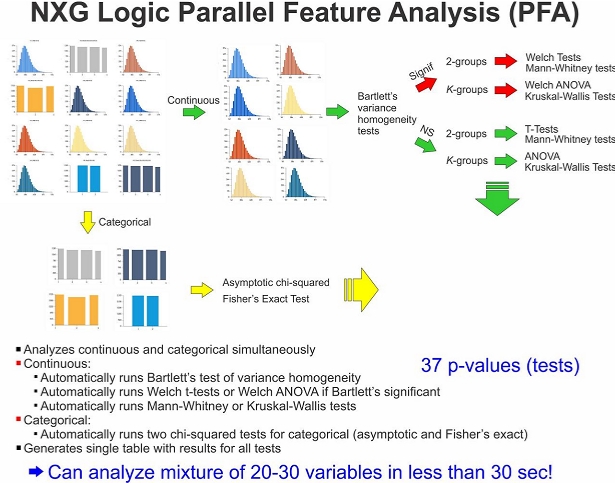NXG Logic Explorer employs Parallel Feature Analysis (PFA) in order to significantly speed up groupwise tests of continuous and categorical features. PFA was developed because of the strong need to save time and boost productivity when workloads involve a lot of monotonous labor-intensive hypothesis tests - which are not complex but are exhaustive in terms of the time required to carry out analyses.
The impetus for developing PFA stemmed from the idea that in a "utopia" world, you would not be bogged down by performing numerous straightforward independent 2- and K -sample parametric and non-parametric equality of means and chi-squared tests on a dozen or more features. For the practicing (experienced) statistician or data scientist, running such tests for several datasets throughout the workday tends to be a waste of time, which could be put to use for complex modelling or tackling big problems. Therefore, a method was needed for short-cutting a way to obtain results quickly. Enter PFA.
Using PFA in Explorer, you no longer need to test for equality of variances across groups for 2- and K-sample tests, since Bartlett's homoscedasticity test is always run on continuous features. If test results are significant, the appropriate Welch test (t-test, ANOVA) is run. Explorer will also run and provide test results for the appropriate non-parametric tests as well, so that users can get a handle on how rank-based methods perform. Leaving statistical power aside for the moment, large differences in test results between parametric and non-parametric tests could possibly reveal strong outlier influences on averages, which are non-existent for non-parametric tests.
The results from a PFA run of a mixture of continuous and categorical features are presented in a pre-formatted color table, which can be printed before research meetings, pasted into Powerpoint for presentations, pasted into Word for manuscripts, or e-mailed to collaborators or customers.
The workflow image below describes the steps taken during PFA. When all is said and done, our belief that researchers and analysts should not spend a half-hour or hour performing groupwise tests. Instead, effort shoud be prioritized for conducting more complex analyses such as developing regression model building strategies and running regression diagnostics, class discovery, class prediction, and simulation.






